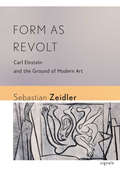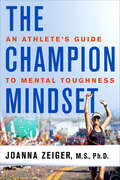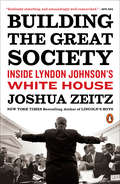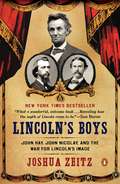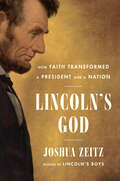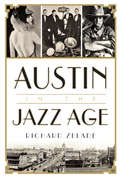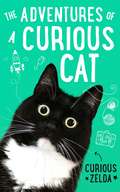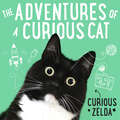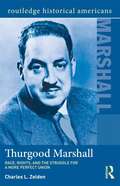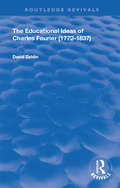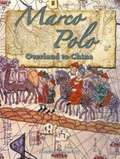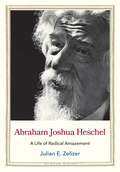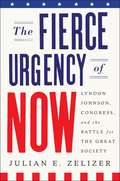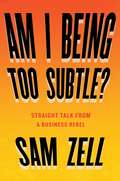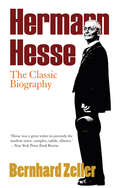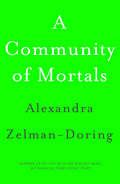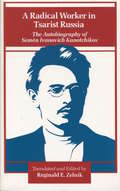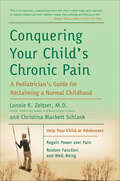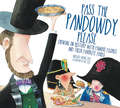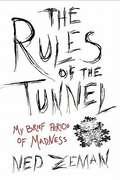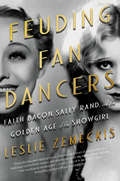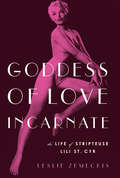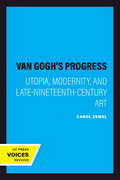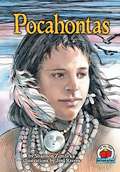- Table View
- List View
Form as Revolt: Carl Einstein and the Ground of Modern Art
by Sebastian ZeidlerThe German writer and art critic Carl Einstein (1885-1940) has long been acknowledged as an important figure in the history of modern art, and yet he is often sidelined as an enigma. In Form as Revolt Sebastian Zeidler recovers Einstein's multifaceted career, offering the first comprehensive intellectual biography of Einstein in English. Einstein first emerged as a writer of experimental prose through his involvement with the anarchist journal Die Aktion. After a few limited forays into art criticism, he burst onto the art scene in 1915 with his book Negro Sculpture, at once a formalist intervention into the contemporary theory and practice of European sculpture and a manifesto for the sophistication of African art. Einstein would go on to publish seminal texts on the cubist paintings of Georges Braque and Pablo Picasso. His contributions to the surrealist magazine Documents (which Einstein cofounded with Georges Bataille), including writings on Picasso and Paul Klee, remain unsurpassed in their depth and complexity. In a series of close visual analyses--illustrated with major works by Braque, Picasso, and Klee--Zeidler retrieves the theoretical resources that Einstein brought to bear on their art. Form as Revolt shows us that to rediscover Einstein's art criticism is to see the work of great modernist artists anew through the eyes of one of the most gifted left-wing formalists of the twentieth century.
The Champion Mindset: An Athlete's Guide to Mental Toughness
by Joanna ZeigerAn in-depth mental motivational book for all athletes from Olympian Dr. Joanna Zeiger that offers game-changing strategies for programming your brain to achieve physical excellence.Champions, as the familiar adage preaches, are not born—they're made. Reaching the top of any sport, or any aspect of life, takes years upon years of dedication and proper preparation. But if there's a huge pool of individuals who have undertaken the same commitment and steps towards becoming the best, what truly separates the winners from everyone else? Joanna Zeiger believes proper mental preparation is the answer. The Champion Mindset is a much-needed and long overdue look into how to program a competitor's mind to achieve optimal success. Changing behaviors and ways of thinking are never easy, but the chapters in this book aim to simplify this process to make it manageable and achievable. This book is for every athlete—from the weekend warrior, who wants to complete in his or her first 5k running race, to those who have aspirations of one day becoming Olympians and world champions.The Champion Mindset is a compendium of Zeiger's own personal journey from struggling novice swimmer to Olympian and World Champion. Through steps including: Proper Goal Setting, Keeping it Fun, Building Your Team, Intention in Training, Improving Motivation, Promoting Self-Confidence, and Mind/Body Cohesion, among others, Zeiger uses her decades of personal experience, doctoral-level research, and professional success, to prepare readers to go all-in with their mental game.
Building the Great Society: Inside Lyndon Johnson's White House
by Joshua ZeitzThe author of Lincoln's Boys takes us inside Lyndon Johnson's White House to show how the legendary Great Society programs were actually put into practice: Team of Rivals for LBJ. The personalities behind every burst of 1960s liberal reform - from civil rights and immigration reform, to Medicare and Head Start."Beautifully written...a riveting portrait of LBJ... Every officeholder in Washington would profit from reading this book." --Robert Dallek, Author of An Unfinished Life: John F. Kennedy, 1917-1963 and Franklin D. Roosevelt: A Political LifeLBJ's towering political skills and his ambitious slate of liberal legislation are the stuff of legend: the Civil Rights Act of 1964, the Voting Rights Act of 1965, Medicare, Medicaid, Head Start, and environmental reform. But what happened after the bills passed? One man could not and did not go it alone. Joshua Zeitz reanimates the creative and contentious atmosphere inside Johnson's White House as a talented and energetic group of advisers made LBJ's vision a reality. They desegregated public and private institutions throughout one third of the United States; built Medicare and Medicaid from the ground up in one year; launched federal funding for public education; provided food support for millions of poor children and adults; and launched public television and radio, all in the space of five years, even as Vietnam strained the administration's credibility and budget.Bill Moyers, Jack Valenti, Joe Califano, Harry McPherson and the other staff members who comprised LBJ's inner circle were men as pragmatic and ambitious as Johnson, equally skilled in the art of accumulating power or throwing a sharp elbow. Building the Great Society is the story of how one of the most competent White House staffs in American history - serving one of the most complicated presidents ever to occupy the Oval Office - fundamentally changed everyday life for millions of citizens and forged a legacy of compassionate and interventionist government.
Lincoln's Boys
by Joshua ZeitzA timely and intimate look into Abraham Lincoln’s White House through the lives of his two closest aides and confidants Lincoln’s official secretaries John Hay and John Nicolay enjoyed more access, witnessed more history, and knew Lincoln better than anyone outside of the president’s immediate family. Hay and Nicolay were the gatekeepers of the Lincoln legacy. They read poetry and attendeded the theater with the president, commiserated with him over Union army setbacks, and plotted electoral strategy. They were present at every seminal event, from the signing of the Emancipation Proclamation to Lincoln’s delivery of the Gettysburg Address-and they wrote about it after his death. In their biography of Lincoln, Hay and Nicolay fought to establish Lincoln’s heroic legacy and to preserve a narrative that saw slavery-not states’ rights-as the sole cause of the Civil War. As Joshua Zeitz shows, the image of a humble man with uncommon intellect who rose from obscurity to become a storied wartime leader and emancipator is very much their creation. Drawing on letters, diaries, and memoirs, Lincoln’s Boys is part political drama and part coming-of-age tale-a fascinating story of friendship, politics, war, and the contest over history and remembrance. .
Lincoln's God: How Faith Transformed a President and a Nation
by Joshua ZeitzLincoln&’s spiritual journey from spiritual skeptic to America's first evangelical Christian presidentbeliever—a conversion that changed both the Civil War and the practice of religion itself.Abraham Lincoln, unlike most of his political brethren, kept organized Christianity at arm&’s length. He never joined a church and only sometimes attended Sunday services with his wife. But as he came to appreciate the growing political and military importance of the Christian community, and when death touched the Lincoln household in an awful, intimate way, the erstwhile skeptic effectively evolved into a believer and harnessed the power of evangelical Protestantism to rally the nation to arms. The war, he told Americans, was divine retribution for the sin of slavery. This is the story of that transformation and the ways in which religion helped millions of Northerners interpret the carnage and political upheaval of the 1850s and 1860s. Rather than focus on battles and personalities, Joshua Zeitz probes ways in which war and spiritual convictions became intertwined. Characters include the famous—Harriet Beecher Stowe, Frederick Douglass, Henry Ward Beecher—as well as ordinary soldiers and their families whose evolving understanding of mortality, heaven, and mission motivated them to fight. Long underestimated in accounts of the Civil War, religion—specifically evangelical Christianity—played an instrumental role on the battlefield and home front, and in the corridors of government. More than any president before him—or any president after, until George W. Bush—Lincoln harnessed popular religious enthusiasm to build broad-based support for a political party and a cause. A master politician who was sincere about his religion, Lincoln held beliefs that were unconventional—and widely misunderstood then, as now. After his death and the end of an unforgiving war, Americans needed to memorialize Lincoln as a Christian martyr. The truth was, of course, considerably more complicated, as this original book explores.
Austin in the Jazz Age
by Richard ZeladeThough renowned, Austin's contemporary music scene pales in comparison with the explosion of creative talent the city spawned during the Jazz Age. Dozens of musicians who started out in the capital city attained national and international fame--but music was just one form of artistic expression that marked that time of upheaval. World War I's death and destruction bred a vehement rejection of the status quo. In its place, an enthusiastic adherence to life lived without question or consequence took root. The sentiment found fertile soil in Austin, with the University of Texas at the epicenter. Students indulged in the debauchery that typified the era, scandalizing Austin and Texas at large as they introduced a freewheeling, individualistic attitude that now defines the city. Join author Richard Zelade in a raucous investigation of the day and its most outstanding and outlandish characters.
The Adventures of a Curious Cat: wit and wisdom from Curious Zelda, purrfect for cats and their humans
by Curious Zelda'A purrfect gift for a loved one with a special affinity for the feline' 'An absolute must for any cat lover''Curiosity is more than a desire to discover. It's a lifestyle, and a purrvilege. It's hours of observing a fly on the wall. It's entering the sock drawer just before it closes. It's sniffing the lampshade one more time . . .'Such is the wisdom of Curious Zelda: social media star, agony aunt, yoga teacher, cat. In The Adventures of a Curious Cat she gives insight into her view of the world and dispenses unparalleled wisdom. Zelda explains, in her unique voice, how to handle humans, how to communicate with furniture, and most importantly how to live a life curiously. It's the ultimate self-help guide for any cat, or indeed, their human.
The Adventures of a Curious Cat: wit and wisdom from Curious Zelda, purrfect for cats and their humans
by Curious Zelda'A purrfect gift for a loved one with a special affinity for the feline''An absolute must for any cat lover''Curiosity is more than a desire to discover. It's a lifestyle, and a purrvilege. It's hours of observing a fly on the wall. It's entering the sock drawer just before it closes. It's sniffing the lampshade one more time . . .'Such is the wisdom of Curious Zelda: social media star, agony aunt, yoga teacher, cat. In The Adventures of a Curious Catshe gives insight into her view of the world and dispenses unparalleled wisdom. Zelda explains, in her unique voice, how to handle humans, how to communicate with furniture, and most importantly how to live a life curiously. It's the ultimate self-help guide for any cat, or indeed, their human.
The Adventures of a Curious Cat: wit and wisdom from Curious Zelda, purrfect for cats and their humans
by Curious Zelda'Curiosity is more than a desire to discover. It's a lifestyle, and a purrvilege. It's hours of observing a fly on the wall. It's entering the sock drawer just before it closes. It's sniffing the lampshade one more time . . .'Such is the wisdom of Curious Zelda: social media star, agony aunt, yoga teacher, cat. In The Adventures of a Curious Cat she gives insight into her view of the world and dispenses unparalleled wisdom. Zelda explains, in her unique voice, how to handle humans, how to communicate with furniture, and most importantly how to live a life curiously. It's the ultimate self-help guide for any cat, or indeed, their human.
Thurgood Marshall: Race, Rights, and the Struggle for a More Perfect Union
by Charles L. ZeldenThurgood Marshall was an Associate Justice of the US Supreme Court from 1967 to 1991. He was the first African American to hold that position, and was one of the most influential legal actors of his time. Before being appointed to the Supreme Court by President Lyndon Johnson, Marshall was a lawyer for the National Association for the Advancement of Colored People (NAACP), Federal Judge (1961-1965), and Solicitor General of the United States (1965-1966). Marshall won twenty-nine of thirty-two cases before the Supreme Court – most notably the landmark case of Brown v. Board of Education, which held segregated public schools unconstitutional. Marshall spent his career fighting racial segregation and legal inequality, and his time on the court establishing a record for supporting the "voiceless American." He left a legacy of change that still affects American society today. Through this concise biography, accompanied by primary sources that present Marshall in his own words, students will learn what Marshall did (and did not do) during his life, why those actions were important, and what effects his efforts had on the larger course of American history.
The Educational Ideas of Charles Fourier: 1772-1837 (Routledge Revivals)
by David ZeldinOriginally published in 1969, this book aims to show that Charles Fourier has much to say that is of interest to modern edcationlists. Fourier hardly ever figures in histories of education because only recent developments in educational practice have shown his ideas to be of topical and practical importance to the schoolteacher and the planner of today. Fourier devised a system of education to suit a self-infulgent, democratic society, in which children's energies could be used in ways which were both socially useful and personally rewarding. He was a pioneer advocate of comprehensive education, so as to establish harmy between classes. He urged vocational training and guidance, so as to establish harmony between men and their work. He devised close links between education and industry, to bring pleasure into both school and work and to integrate the two. He was one of the first to plan social service to the community by children. This prophetic though eccentric writer, sometimes extravagant, often amusing, but always endearing, who has already exerted much influence on socialist theory, deserves to be better known by students of education.
In the Footsteps of Explorers: Marco Polo Overland to China
by Alexander ZelenyjMarco Polo was an Italian explorer who travelled to Asia, where he served in the court of China's great Mongol emperor Kublai Khan. By writing a book of his discoveries and adventures, Marco offered Europe its first look at eastern cultures and traditions.
Abraham Joshua Heschel: A Life of Radical Amazement (Jewish Lives)
by Julian E. ZelizerA biography of the rabbi Abraham Joshua Heschel, who became a symbol of the marriage between religion and social justice &“When I marched in Selma, I felt my legs were praying.&” So said Polish-born American rabbi Abraham Joshua Heschel (1907–1972) of his involvement in the 1965 Selma civil rights march alongside Martin Luther King Jr. Heschel, who spoke with a fiery moralistic fervor, dedicated his career to the struggle to improve the human condition through faith. In this new biography, author Julian Zelizer tracks Heschel&’s early years and foundational influences—his childhood in Warsaw and early education in Hasidism, his studies in late 1920s and early 1930s Berlin, and the fortuitous opportunity, which brought him to the United States and saved him from the Holocaust, to teach at Hebrew Union College and the Jewish Theological Seminary. This deep and complex portrait places Heschel at the crucial intersection between religion and progressive politics in mid-twentieth-century America. To this day Heschel remains a symbol of the fight to make progressive Jewish values relevant in the secular world.
The Fierce Urgency Of Now: Lyndon Johnson, Congress and The Battle for The Great Society
by Julian E. ZelizerA majestic big-picture account of the Great Society and the forces that shaped it, from Lyndon Johnson and members of Congress to the civil rights movement and the media. Between November 1963, when he became president, and November 1966, when his party was routed in the midterm elections, Lyndon Johnson spearheaded the most transformative agenda in American political history since the New Deal, one whose ambition and achievement have had no parallel since. In just three years, Johnson drove the passage of the Civil Rights and Voting Rights Acts; the War on Poverty program; Medicare and Medicaid; the National Endowments for the Arts and the Humanities; Public Broadcasting; immigration liberalization; a raft of consumer and environmental protection acts; and major federal investments in public transportation. Collectively, this group of achievements was labeled by Johnson and his team the "Great Society. " In The Fierce Urgency of Now, Julian E. Zelizer takes the full measure of the entire story in all its epic sweep. Before Johnson, Kennedy tried and failed to achieve many of these advances. Our practiced understanding is that this was an unprecedented "liberal hour" in America, a moment, after Kennedy's death, when the seas parted and Johnson could simply stroll through to victory. As Zelizer shows, this view is off-base: In many respects America was even more conservative than it seems now, and Johnson's legislative program faced bitter resistance. The Fierce Urgency of Now animates the full spectrum of forces at play during these turbulent years, including religious groups, the media, conservative and liberal political action groups, unions, and civil rights activists. Above all, the great character in the book whose role rivals Johnson's is Congress-indeed, Zelizer argues that our understanding of the Great Society program is too Johnson-centric. He discusses why Congress was so receptive to passing these ideas in a remarkably short span of time and how the election of 1964 and burgeoning civil rights movement transformed conditions on Capitol Hill. Zelizer brings a deep, intimate knowledge of the institution to bear on his story: The book is a master class in American political grand strategy. Finally, Zelizer reckons with the legacy of the Great Society. Though our politics have changed, the heart of the Great Society legislation remains intact fifty years later. In fact, he argues, the Great Society shifted the American political center of gravity-and our social landscape-decisively to the left in many crucial respects. In a very real sense, we are living today in the country that Johnson and his Congress made.
Am I Being Too Subtle?: Straight Talk From a Business Rebel
by Sam ZellThe traits that make Sam Zell one of the world’s most successful entrepreneurs also make him one of the most surprising, enigmatic, and entertaining mavericks in American business. Self-made billionaire Sam Zell consistently sees what others don’t. From finding a market for overpriced Playboy magazines among his junior high classmates, to buying real estate on the cheap after a market crash, to investing in often unglamorous industries with long-term value, Zell acts boldly on supply and demand trends to grab the first-mover advantage. And he can find opportunity virtually anywhere—from an arcane piece of legislation to a desert meeting in Abu Dhabi. “If everyone is going left, look right,” Zell often says. To him, conventional wisdom is nothing but a reference point. Year after year, deal after deal, he shuts out the noise of the crowd, gathers as much information as possible, then trusts his own instincts. He credits much of his independent thinking to his parents, who were Jewish refugees from World War II. Talk to any two people and you might get wild swings in their descriptions of Zell. A media firestorm ensued when the Tribune Company went into bankruptcy a year after he agreed to steward the enterprise. At the same time, his razor-sharp instincts are legendary on Wall Street, and he has sponsored over a dozen IPOs. He’s known as the Grave Dancer for his strategy of targeting troubled assets, yet he’s created thousands of jobs. Within his own organization, he has an inordinate number of employees at every level who are fiercely loyal and have worked for him for decades. Zell’s got a big personality; he is often contrarian, blunt, and irreverent, and always curious and hardworking. This is the guy who started wearing jeans to work in the 1960s, when offices were a sea of gray suits. He’s the guy who told The Wall Street Journal in 1985, “If it ain’t fun, we don’t do it.” He rides motorcycles with his friends, the Zell’s Angels, around the world and he keeps ducks on the deck outside his office. As he writes: “I simply don’t buy into many of the made-up rules of social convention. The bottom line is: If you’re really good at what you do, you have the freedom to be who you really are.” Am I Being Too Subtle?—a reference to Zell’s favorite way to underscore a point—takes readers on a ride across his business terrain, sharing with honesty and humor stories of the times he got it right, when he didn’t, and most important, what he learned in the process. This is an indispensable guide for the next generation of disrupters, entrepreneurs, and investors.
Hermann Hesse: An Illustrated Biography
by Bernhard ZellerAn illustrated biography drawing on Hesse's own work and on the recollections of his family and friendsBernhard Zeller depicts Herman Hesse's ancestry and childhood, spent in the small German town where Hesse was born in 1877, and traces his adolescence and early manhood. He describes his relationship with his first wife, his emigration to Switzerland in protest against German militarism, his Jungian psychoanalysis, the visit to India which inspired his narrative masterpieces Siddhartha and Journey to the East, and the breakup of his marriage. Hesse's growing Iiterary reputation coincided with his brief second marriage, and with his peaceful later years in Montagnola spent in the company of his third wife, Ninon, whom he married in 1931. His stature was not fully recognized outside German-speaking countries until after his death in 1962. Zeller also recalls Hesse's circle of friends, including his famous contemporaries such as Thomas Mann and Andre Gide. This valuable documentary portrait is illustrated with photographs from Hermann Hesse's private collection. In addition, it includes a bibliography and chronology.
A Community of Mortals
by Alexandra Zelman-DoringWhat is it like to have someone die in your arms? Can we return from the dead? And why has nobody heard of therapeutic hypothermia? Forced to come to terms with doctors pronouncing her husband ‘clinically dead’, Alexandra Zelman-Doring embarks on an exploration of what death means to us and how we might face it. Initally she is overwhelmed by the difficulty of accepting the loss of a loved one, and the anger, sadness and sense of isolation that it brings. But her suffering pushes her towards a life-store of reading, and here she finds words with which to contemplate death; from Turgenev on death as an ‘unanswerable reproach’ to Norbert Elias on the extraordinary collective will to endure it.Equally inspiring are the true stories of unlikely survivors: from a species of frog whose organs stop, frozen, throughout the winter, only to stir back to life in the spring, to Anna Bagenholm whose iced brain and body held out against all odds after a fatal accident. These incidents inform a development in medical science where cardiac arrest is treated with ‘therapeutic hypothermia’, in some cases allowing the body to last without oxygen just long enough for doctors to return the near-dead to life.
A Radical Worker In Tsarist Russia: The Autobiography Of Semen Ivanovich Kanatchikov
by Reginald E. ZelnikSemën Kanatchikov, born in a central Russian village in 1879, was one of the thousands of peasants who made the transition from traditional village life to the life of an urban factory worker in Moscow and St. Petersburg in the last years of the nineteenth century. Unlike the others, however, he recorded his personal and political experiences (up to the even of the 1905 Revolution) in an autobiography. First published in the Soviet Union in the 1920s, this memoir gives us the richest and most thoughtful firsthand account we have of life among the urban lower classes in Imperial Russia. We follow this shy but determined peasant youth's painful metamorphosis into a self-educated, skilled patternmaker, his politicization in the factories and workers' circles of Moscow and St. Petersburg, and his close but troubled relations with members of the liberal and radical intelligentsia. Kanatchikov was an exceptionally sensitive and honest observer, and we learn much from his memoirs about the day-to-day life of villagers and urban workers, including such personal matters as religious beliefs, family tensions, and male-female relationships. We also learn about conditions in the Russian prisons, exile life in the Russian Far North, and the Bolshevik-Menshevik split as seen from the workers' point of view.
Conquering Your Child's Chronic Pain: A Pediatrician's Guide for Reclaiming a Normal Childhood
by Lonnie K. Zeltzer“An important, compassionate book.” — Deepak Chopra“Parents! If you hava child in pain, read this book. There is hope.” — James Campbell, M.D., Professor of Jeurological Surgery and Director, Johns Hopkins University School of Medicine; Founder and President, American Pain Foundation“An outstanding book for parents of children and adolescents with chronic pain. I recommend it highly.” — Charles Berde, M.D., Ph.D., Chief, Division of Pain Medicine, Department of Anesthesiology, Children's Hospital, Boston; Professor of Anaesthesia and Pediatrics, Harvard Medical School“A valuable and important book that will be appreciated by every family struggling with a child in pain.” — Neil L. Schechter, M.D., Professor of Pediatrics, University of Connecticut School of Medicine; Director, Pain Relief Program, Connecticut Children's Medical Center“Reassuring and informative. Parents will gain hope when they discover the many available treatment options.” — Kenneth R. Goldschneider, M.D., F.A.A.P., Director, Division of Pain Management, Cincinnati Children's Hospital Medical Center and Susmita Kashikar-Zuck, Ph.D, Associate Professor of Pediatrics, Cincinnati Children's Hospital Medical Center“I hope Dr. Zeltzer continues to do subjective research on yoga so that the young generation regains freedom from pain...” — B.K.S. Iyengar“A wonderful book! Dr. Zeltzer’s approach is loving, respectful, upbeat, and best of all - successful.” — Laura Schanberg, M.D., Associate Professor, Pediatric Rheumatology, Duke University Medical Center“A must-read for any patient with chronic pain.” — Steven J. Weisman, M.D., Jane B. Pettit Chair in Pain Management, Children's Hospital of Wisconsin; Professor of Anesthesiology and Pediatrics, Medical College of Wisconsin“Now [Dr. Zeltzer’s] wisdom is available to all.” — Patrick J. McGrath, O.C., Ph.D., F.R.S.C., Canadian Institutes of Health Research Distinguished Scientist; Killam Professor of Psychology and Professor of Pediatrics and Psychiatry, Dalhousie University“This is an amazingly caring, competent, and useful book. It opens your mind but also your heart...” — Vanna Axia, Ph.D., Professor of Developmental Psychology, Child Neuro-psychiatry Specialization School, School of Medicine; Director“All [Dr. Zeltzer’s] work has resulted in real solutions for children and their parents.” — David Geffen“One of the few [books] for laypeople on chronic pain in children.” — Washington Post“Informative, practical, and well written.” — Pediatric Pain Letter
Pass The Pandowdy, Please: Chewing On History With Famous Folks And Their Fabulous Foods
by Abigail Zelz Eric Zelz*CBC/NCSS Notable Social Studies Trade Book* What do Napoleon, Cleopatra, George Washington, Gandhi, Queen Victoria, Columbus, Neil Armstrong, Montezuma, Paul Revere, Babe Ruth, Abraham Lincoln, Sacagawea, and Katsushika Hokusai have in common? They are all among the historical figures portrayed in this delightful book by writer Abby Ewing Zelz and cartoonist Eric Zelz. Just like us, the great movers and shakers of history had to eat, and their favorite foods turn out to be a highly entertaining thread to follow through the history of our small planet. History and biography have never been this tasty! Includes do it yourself historic Pandowdy recipe Includes backmatter with brief bios of featured historic figures Fountas & Pinnell Level W
The Rules of the Tunnel
by Ned ZemanA journalist faces his toughest assignment: profiling himself as he struggles with mood disorders, memory, shock treatment therapy, and the quest to get back to normal. Twenty-five million Americans suffer from clinical depression. But Ned Zeman never thought he’d be one of them. He had a great life and thriving career at Vanity Fair. Then, at age thirty-two, anxiety and depression gripped Zeman with increasing violence and consequences. He experimented with therapist after therapist, medication after medication, hospital after hospital—including McLean Hospital, the facility famed for its treatment of writers, from Sylvia Plath to Susanna Kaysen to David Foster Wallace. Zeman eventually went further by trying electroconvulsive therapy, aka shock treatment. By the time it was over, Zeman had lost nearly two years’ of memory. He was a reporter with amnesia. He had no choice but to start from scratch, to reassemble the pieces of a life he didn’t remember and, increasingly, didn’t want to. By turns hilarious and heartbreaking, profane and hopeful, The Rules of the Tunnel is a guttural shout of a book that defies conventional notions about mood disorders, unlocks mysteries within mysteries, and proves that sometimes everything you’re looking for is right in front of you. .
Feuding Fan Dancers: Faith Bacon, Sally Rand, and the Golden Age of the Showgirl
by Leslie ZemeckisDiscover two forgotten icons from the golden age of entertainment: the lost stories of Sally Rand and Faith Bacon—women who each claimed to be the inventor of the notorious fan dance in this "detailed, deeply researched, and compelling" feminist history (Chicago Tribune).Some women capture our attention like no others. Faith Bacon and Sally Rand were beautiful blondes from humble backgrounds who shot to fame behind a pair of oversize ostrich fans, but with very different outcomes. Sally Rand would go on to perform for the millions who attended the 1933 World&’s Fair in Chicago, becoming America&’s sweetheart. Faith Bacon—the Marilyn Monroe of her time who was once anointed the &“world&’s most beautiful woman&”—would experience the dark side of fame and slip into drug use.It was the golden age of American entertainment, and Bacon and Rand fought their way through the competitive showgirl scene of New York with grit and perseverance. They played peek-a-boo with their lives, allowing their audiences to see only slivers of themselves. A hint of a breast? A forbidden love affair? They were both towering figures, goddesses, icons. Until the world started to change. Little is known about who they really were, until now.Feuding Fan Dancers tells the story of two remarkable women during a tumultuous time in entertainment history. Leslie Zemeckis has pieced together their story and—nearly one hundred years later—both women come alive again.
Goddess of Love Incarnate: The Life of Stripteuse Lili St. Cyr.
by Leslie ZemeckisLili St. Cyr was, in the words of legendary reporter Mike Wallace, the "highest paid stripteaser in America."<P><P> Wallace was so fascinated by Lili that out of all the presidents and celebrities he interviewed over a long career, towards the end of his life, she was the one he remained fixated on. Her beauty had that kind of effect.Lili St. Cyr, the one time queen of burlesque, led an incredible life -six marriages, romances with Orson Wells, Yul Brenner, Vic Damone, a number of suicide attempts, all alongside great fame and money. Yet despite her fierce will she lost it all; becoming a recluse in her final decades, she eked out a living selling old photos of herself living with magazines taped over her windows.Goddess of Love Incarnate will be the definitive biography of this legendary figure, done with the cooperation of Lili's only surviving relative. But the book does more than fascinate readers with stories of a byone era. St. Cyr was ahead of her time in facing the perils and prejudices of working women, and the book offers a portrait of a strong artistic figure who went against the traditional roles and mores expected of women at
Van Gogh's Progress: Utopia, Modernity, and Late-Nineteenth-Century Art (California Studies in the History of Art #36)
by Carol ZemelThis title is part of UC Press's Voices Revived program, which commemorates University of California Press’s mission to seek out and cultivate the brightest minds and give them voice, reach, and impact. Drawing on a backlist dating to 1893, Voices Revived makes high-quality, peer-reviewed scholarship accessible once again using print-on-demand technology. This title was originally published in 1997.This title is part of UC Press's Voices Revived program, which commemorates University of California Press’s mission to seek out and cultivate the brightest minds and give them voice, reach, and impact. Drawing on a backlist dating to 1893, Voices Revived</DIV
Pocahontas (On My Own Biography)
by Shannon ZemlickaAs the young daughter of a powerful Powhatan leader, Pocahontas befriended the English settlers in Jamestown, Virginia. Although she helped them survive their difficult first years, and she may have saved settler John Smith's life, they took Pocahontas captive. After her release, Pocahontas married an English settler and journeyed to England. Although she was just twenty-one years old when she died, Pocahontas changed American history through her compassion and friendship.
